
Site plan of El Mirador. This looked like you could see a lot of buildings, but that was misleading. (867k)
From the El Mirador entry in Wikipedia:
El Mirador (which translates as "the lookout", "the viewpoint", or "the belvedere") is a large pre-Columbian Maya settlement, located in the north of the modern department of El Petén, Guatemala.
El Mirador flourished from about the 6th century BCE to the 1st century CE, reaching its height from the 3rd century BCE. Then it experienced a hiatus of construction and perhaps abandonment for generations, followed by re-occupation and further construction in the Late Classic era, and a final abandonment about the end of the 9th century. The civic center of the site covers some 10 km² (4 square miles) with several thousand structures, including monumental architecture from 10 - 72 m (30 - 236 ft) high.
There is a number of "triadic" structures (around 35 structures), consisting of large artificial platforms topped with a set of 3 summit pyramids. The most notable of such structures are three huge complexes; one is nicknamed "El Tigre", with a height of 55 m (180 ft); the other is called "La Danta" (or Danta) temple. The La Danta temple measures approximately 72 m (236 ft) tall from the forest floor, and considering its total volume (2,800,000 m³ (98.9 million cubic feet)) is one of the largest pyramids in the world. When the large man-made platform that the temple is built upon (some 180,000 m² (1,938,000 square feet)) is included in calculations, La Danta is considered by some archaeologists to be one of the most massive ancient structures in the world. Also the "Los Monos" complex is very large (48 m (157 ft) high) although not as well known. Most of the structures were originally faced with cut stone which was then decorated with large stucco masks depicting the deities of Maya mythology. According to Carlos Morales-Aguilar, a Guatemalan archaeologist from Pantheon-Sorbonne University, the city appears to have been planned from its foundation, as extraordinary alignments have been found between the architectural groups and main temples, which were possibly related to solar alignments. The study reflects an importance of urban planning and sacred spaces since the first settlers.
FARES, the Foundation for Anthropological Research & Environmental Studies, has a description of El Mirador.
There is currently no road going to El Mirador. To visit, you can either hike or ride. Short visits by helicopter are also possible. I was originally scheduled to hike. When I was picked up in Flores, I was told that I could ride as well. I decided to do that, and I am glad that I did. I would never have been able to make the hike. It is 16 km (10 miles) on the first day, from Carmelita to the La Tintal camp. On the second day it is 27 km (17 miles) from La Tintal to El Mirador. The trail was flooded and extremely muddy. I spent 5 hours on mule-back each day. On the first day, my guide was guiding my mule. On the second day my mule was number three in the mule train. When the number two mule started farting, I was reminded of a German childhood rhyme: "Und keiner wollte hinten gehn, denn hinten war the Luft nicht schön". This translates to "And nobody wanted to walk in the rear, because in the rear the air wasn't clear."
It was quite an adventure. I am glad that I did this trek, but I wouldn't do it again.
It was interesting to see the huge temples. However, only a few structures are excavated, mostly you just see tree-covered earth mounds. You can climb up on El Tigre and on La Danta, the largest structure. La Danta is the largest Maya structure in the world. Most of the structures apparently were covered with painted stucco sculptures. They used three colors, black, red, and creme. There are some of the stucco friezes with remnants of the original paint left.
All pictures are © Dr. Günther Eichhorn, unless otherwise noted.





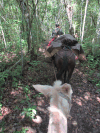










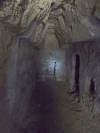





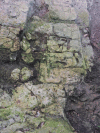







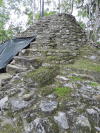


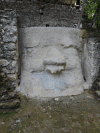










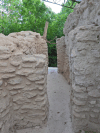







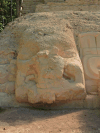
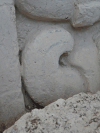
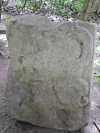
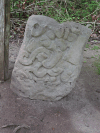



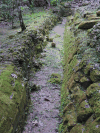

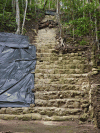
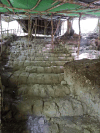
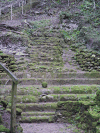




This page contains 68 pictures
Page last updated on Tue Oct 27 12:56:27 2020 (Mountain Standard Time)
Page last updated on Fri Apr 26 06:06:33 2024 (Mountain Standard Time)